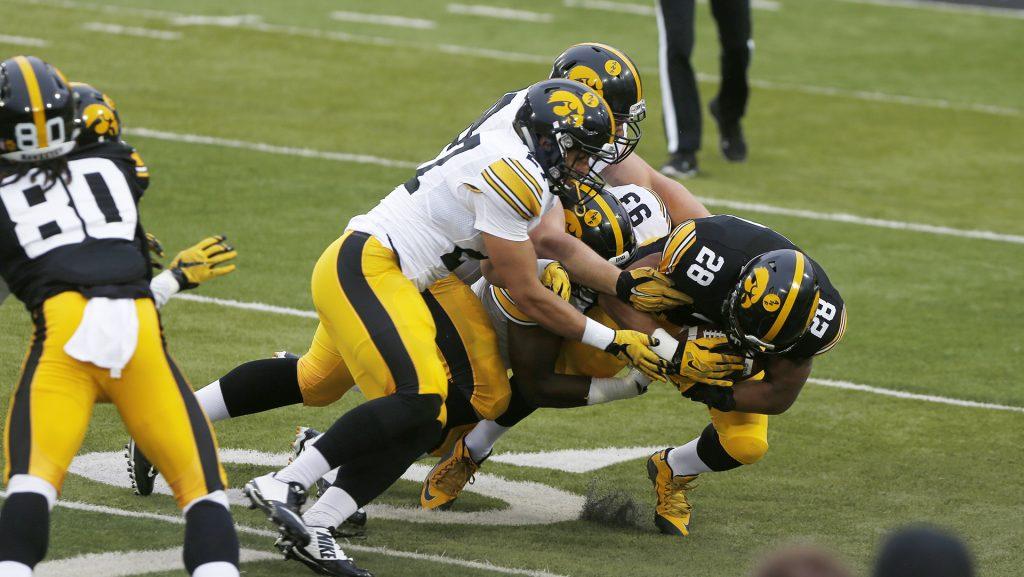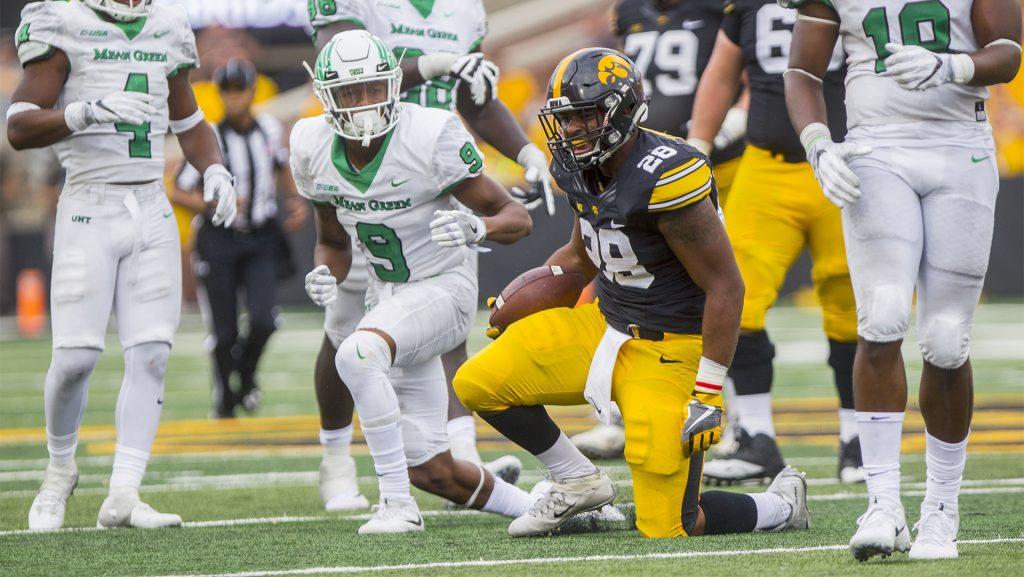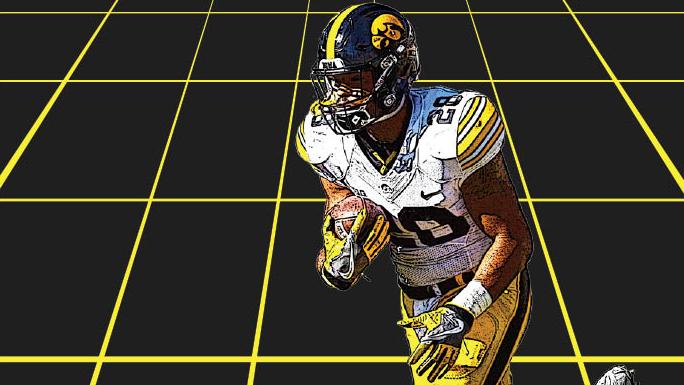When one door closes, another door opens.
For Iowa running back Toren Young, this statement rings true.
The Madison, Wisconsin, native grew up a Badger fan, but during his recruiting period, he realized his childhood dreams might not come to fruition.
“Going into high school and knowing that I had the dreams to play college football, I knew I had to be open-minded,” Young said. “I knew that playing at home might not be a possibility.”
Young’s high-school statistics rose exponentially as he moved up each year. As a sophomore, he ran for 1,134 yards and 11 touchdowns. By his senior year, the 5-11, 220-pound tailback racked up 2,779 yards and 28 touchdowns at Monona Grove High School.
His accolades mirrored his on-field success — in his senior year alone, Young was named to the Blue-Grey All-American team and first-team All-State, earned conference and area Player of the Year, and was a finalist for the Elroy “Crazy Leg” Hirsch Award.
Despite being swamped with accolades, recruiting did not follow suit.
“I wasn’t a highly recruited kid,” Young said. “I got letters here and there and took a couple of game visits to places.”
The Badgers never offered.
RELATED: Around the Big Ten: Week 6 power rankings
Instead, Young looked elsewhere, but it wasn’t a forced decision. If anything, Wisconsin’s failure to offer Young a scholarship was a blessing in disguise.
He visited Iowa numerous times and attended a few games during the recruiting process, falling in love with both the campus and the Hawkeye program.
“I felt like it was the perfect fit for me,” Young said. “I felt the stuff I believe in — being hard-nosed, tough, physical — that’s what this program exemplifies. I knew I could be a fit here.”
In his first season at Iowa, Young redshirted.
The Hawkeyes churned out 2,000-yard rushers in 2016, LeShun Daniels Jr. and Akrum Wadley, and many viewed Young as a tailback groomed to move into that two-back rotation once Daniels graduated.
“He’s more of a strong back like LeShun or Shonn Greene,” head coach Kirk Ferentz said during the spring season. “[I] hate to start throwing names out of guys who are accomplished players, [but] Marcus Coker is another name that comes to mind.”
To put that in perspective, Daniels scored 18 touchdowns over the course of the previous two seasons, Greene — the 2008 Doak Walker Award winner — ran for 1,850 yards and 20 touchdowns in 2008, and Coker rushed for 1,384 yards and 15 touchdowns in his final season as a Hawkeye in 2011.
At Iowa’s spring practice in West Des Moines in April, Ferentz highlighted Young as one of the redshirt players that improved drastically since he first arrived on campus.

“Early on, when I came in, I had high pad level,” Young said. “Being a physical back and priding yourself on being physical, you can’t run high. [My coaches] really coached me on getting my pad level down.”
Power running stems from a low pad level — the running back gets lower position and initiates the contact rather than running upright and waiting to be hit.
After working hard to get his technique right, Young may have expected to be No. 2 on the depth chart. Ultimately, though, Young has had to wait longer than expected to put his power-running style on display; he found himself lower on the depth chart than anticipated.
Iowa added another running back, graduate transfer James Butler, during the off-season.
The Hawkeyes aren’t known for taking graduate transfers, but Butler’s situation was unique; he arrived on campus with a respectable résumé: 3,316 yards and 30 touchdowns over the course of three seasons with the Wolfpack.
Young’s mindset didn’t change, even after losing his potential spot to a new Hawkeye. If anything, Butler’s arrival brought added competition in the running-back unit.
“You got to come in here every day ready to work,” Young said. “From the beginning, bringing Butler in, that makes it more competitive here, which is good for the offense as a whole.”
Hawkeye football preaches a next-man-up mentality, something that played out specifically for Young.
On Sept. 16, Iowa squared up with North Texas for its final nonconference game of the season. The game was closer than fans had hoped and expected.
For most of the contest, neither team could establish consistency. Running back Akrum Wadley scored on a long catch and run, but an unsportsmanlike-conduct penalty erased his touchdown.
Wadley exited the game in the first half, having tweaked his ankle, leaving Butler as the lead ball carrier.
Young saw his first carry of his Hawkeye career on Iowa’s final drive of the half — a 5-yard rush in an attempt to relieve Butler from his sudden up-tick in carries.
RELATED: Freshman backs come up clutch in wake of injuries
In the second half, however, an injury decimated Butler’s workload. He put together his best game of the season — a 16-carry, 77-yard performance — before he followed Wadley off the field.
Iowa turned to two unproven, untested running backs: Young and true freshman Ivory Kelly-Martin.
Opportunity knocked against North Texas, and Young was ready, thanks to embracing a studious role and taking notes from the veteran backs ahead of him on the depth chart.
“We got a good running-back crew, and there are two really good backs in front of me, so I’m just sitting back learning a lot from them,” Young said. “They always tell me when my number’s called to be ready.”
The pair chewed away at the clock, keeping North Texas’ offense off the field (two of the Hawkeyes’ touchdown drives in the second half took at least 6:52), and helping Iowa’s offense score 21 unanswered points. Butler never returned to the game, and he continues to miss time because of that injury, leaving Iowa with Wadley, Young, and Kelly-Martin to work with.
When the final whistle blew, Young’s carries stood at 19. He gained 78 yards on the ground, including a 15-yard run, averaging a solid 4.1 yards per carry.
“The young guys, certainly, who jumped in did a great job, too; they really helped us out,” offensive lineman Sean Welsh said.
Young almost punched the ball into the end zone on Iowa’s final possession after the Hawkeyes took over following cornerback Josh Jackson’s interception with under two minutes remaining.
In Mean Green territory, Young rushed through a hole for 15 yards. Next, he followed that run with an 11-yard gain, setting Iowa up at the North Texas 2-yard line.

But with the clock winding down and Iowa not wanting to run up the score, Ferentz opted to take a knee and run out the clock.
Fans licked their chops for another Hawkeye touchdown, but Young was more than happy not to get the ball one last time.
“I’m just happy we won the game,” he said later that day. “Taking a knee is a smart decision.”
Taking a knee put Young’s first Hawkeye touchdown on hold, but as the old saying goes, good things come to those who wait.
Young hasn’t seen the field since the win over the Mean Green, despite Butler’s absence; Wadley took almost every snap against Penn State and Michigan State, with a handful of carries going to Kelly-Martin. The Hawkeyes couldn’t muster much on the ground in both games. Searching for answers in the running game, Ferentz might change things; Young might find his way back onto the field as soon as this weekend against Illinois.



